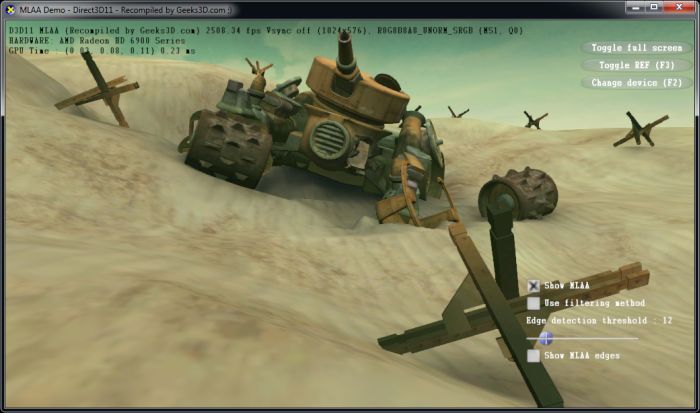
AMD has published a Direct3D 11 demo about MLAA (MorphoLogical Anti-Aliasing). For more information about MLAA, read this post.
This sample demonstrates a post-process pixel shader technique that applies Fullscreen Anti-
Aliasing to an image. Morphological Antialiasing (MLAA) was originally developed by Intel Lab
(see reference) but was designed for a CPU based post-process. This sample demonstrates a
modified MLAA implementation adapted to run on the GPU.Recently, deferred rendering has been playing a more and more important role in the game
industry. One of the advantages of MLAA is that it works well with deferred or semi-deferred
rendering techniques while traditional MSAA is more difficult to implement and much more
costly from a performance perspective. Another advantage of MLAA is that it is very simple to
integrate into existing rendering systems because it works as a post process operation. Finally
post-process FSAA techniques like MLAA work on every pixel on the screen which means that
edges resulting from the use of semi-transparent textures also benefit from anti-aliasing.
You can download the source code HERE (Visual Studio 2008). Funny thing, seems AMD has a too strong security system, because the demo executable has been removed during the packaging. There is a MLAA11.txt file in the RAR archive that says:
FILE QUARANTINED
Microsoft Forefront Security for Exchange Server removed a file since it was found to match a filter.
File name: “winmail.dat->MLAA11.rar->MLAA11\MLAA11.exe”
Filter name: “FILE FILTER= AMDDelete: *.exe”
But it’s not a problem for Geeks3D. Here is the win32 demo recompiled for your pleasure:
|
AMD MLAA Direct3D 11 demo: Webmasters: hotlinking is not allowed, please use the post url as download link. [download#273#image] |
|
You have to install the latest DX runtimes (June 2010) to run the demo. You can download DirectX end-user runtimes (June 2010) HERE.
I tested the demo with a SAPPHIRE Radeon HD 6970 and latest Catalyst 12.1:
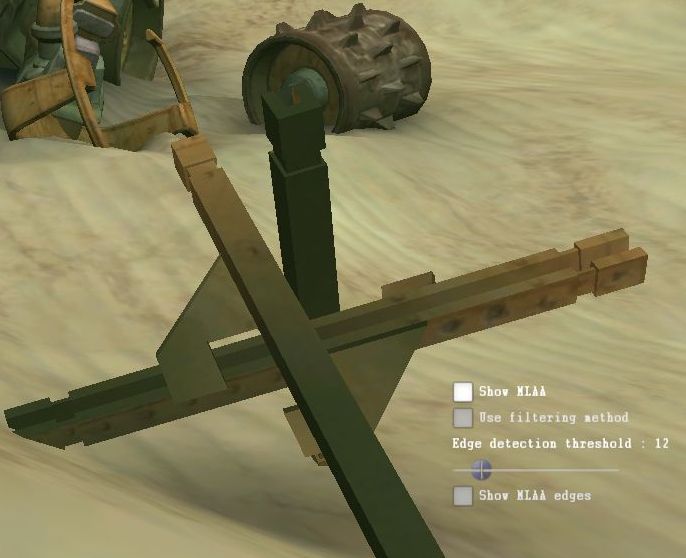
No MLAA – FPS:3640 (res:1524×914)
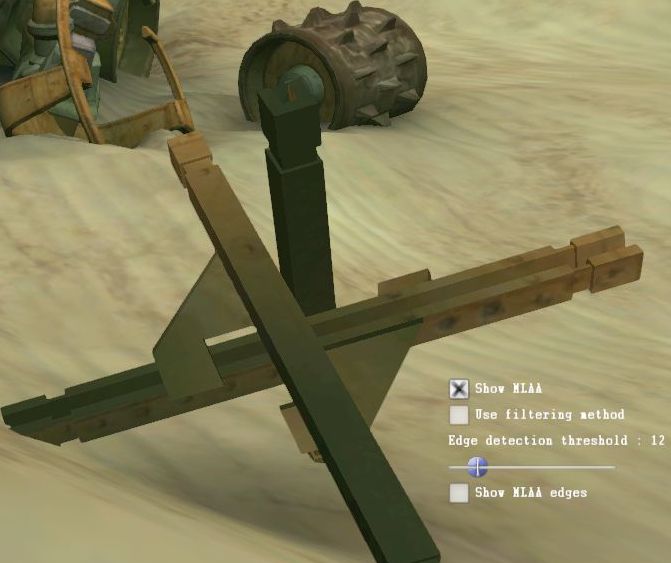
MLAA enabled, threshold: 12 – FPS:1358 (res:1524×914)
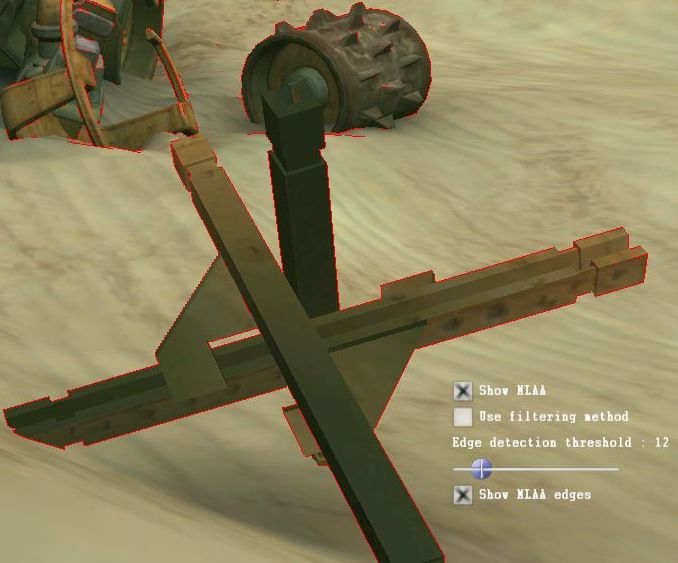
MLAA enabled, MLAA edges for threshold: 12
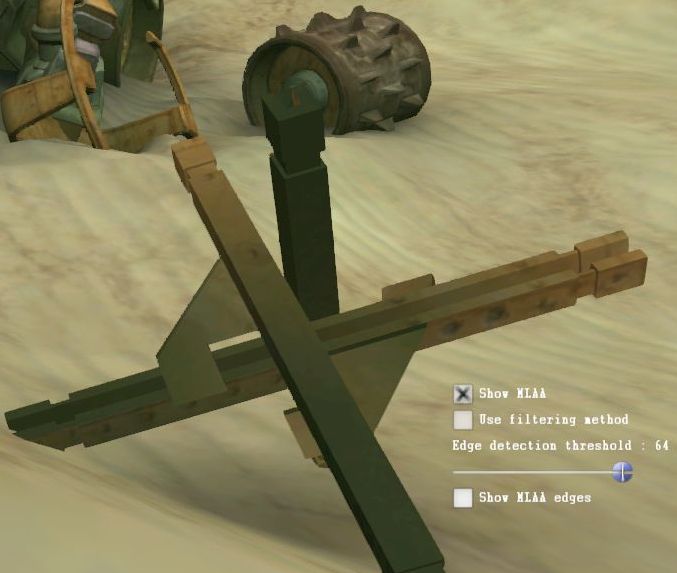
MLAA enabled, threshold: 64 – FPS:1071 (res:1524×914)
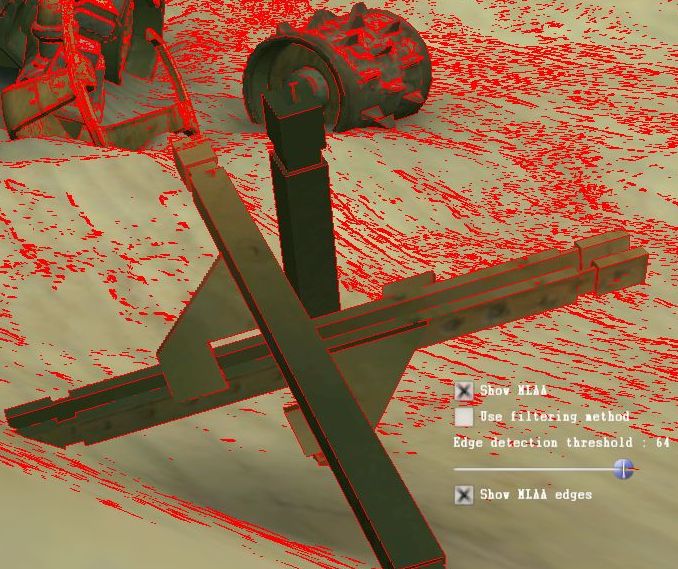
MLAA enabled, MLAA edges for threshold: 64

MLAA enabled, threshold: 12 – FPS:1358 (res:1524×914)

MLAA disabled – FPS:3640 (res:1524×914)
Source: Geeks3D forum
AMD’s trolling us. 😆
Nice job jego!
hmm isn’t SMAA (released with binary + sources as well) supposed to be superior?
isn’t FXAA also supposed to be superior?
@Gregory – MLAA forced by drivers… may suck, MLAA supported by game engine >> MLAA forced by drivers.
Anti-aliasing is the new shadowing. The multitude of AA techniques developed these days remind of me the boom in shadowing techniques in 2000s.
FXAA is just an approximation of MLAA: http://iryoku.com/aacourse/downloads/09-FXAA-3.11-in-15-Slides.pdf
It’s faster, but a bit worse quality.
SMAA is also MLAA implementation on GPU.
DX11 they say, it runs just fine on my 3870, i did get about 1000FPS+ difference when MLAA is off and about 300FPS when is on.
Hey Jego, the 7970 Leo demo is now up!
http://developer.amd.com/samples/demos/pages/AMDRadeonHD7900SeriesGraphicsReal-TimeDemos.aspx
Announce it if you want! 🙂
@Psolord: tested and posted: http://www.geeks3d.com/20120128/amd-radeon-hd-7900-series-direct3d-11-demo-leo-in-sneeze-the-day/
Someone else’s take on MLAA: SMLAA
http://vertexasylum.com/2012/02/19/symmetrical-morphological-anti-aliasing/
Runs twice as fast as the AMD’s MLAA (in higher resolutions / on slower GPUs)!
http://vertexasylum.com/2012/02/19/symmetrical-morphological-anti-aliasing/